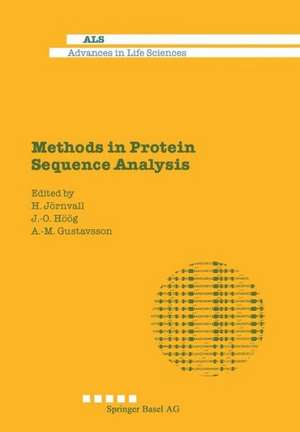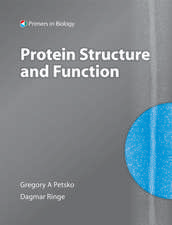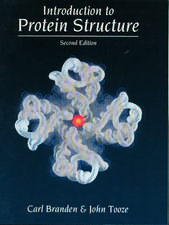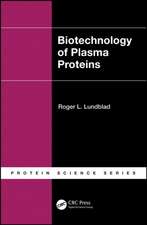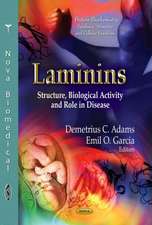Methods in Protein Sequence Analysis: Advances in Life Sciences
Autor Jörnvall, Höögen Limba Engleză Paperback – 23 aug 2014
Din seria Advances in Life Sciences
- 15%
 Preț: 646.11 lei
Preț: 646.11 lei - 15%
 Preț: 645.96 lei
Preț: 645.96 lei - 15%
 Preț: 650.86 lei
Preț: 650.86 lei - 5%
 Preț: 365.99 lei
Preț: 365.99 lei -
 Preț: 417.02 lei
Preț: 417.02 lei -
 Preț: 394.51 lei
Preț: 394.51 lei -
 Preț: 387.20 lei
Preț: 387.20 lei -
 Preț: 391.02 lei
Preț: 391.02 lei -
 Preț: 405.87 lei
Preț: 405.87 lei -
 Preț: 389.70 lei
Preț: 389.70 lei -
 Preț: 400.26 lei
Preț: 400.26 lei -
 Preț: 399.88 lei
Preț: 399.88 lei -
 Preț: 396.62 lei
Preț: 396.62 lei -
 Preț: 409.69 lei
Preț: 409.69 lei -
 Preț: 395.47 lei
Preț: 395.47 lei -
 Preț: 390.25 lei
Preț: 390.25 lei -
 Preț: 382.95 lei
Preț: 382.95 lei -
 Preț: 387.38 lei
Preț: 387.38 lei - 15%
 Preț: 647.59 lei
Preț: 647.59 lei
Preț: 398.15 lei
Nou
Puncte Express: 597
Preț estimativ în valută:
76.21€ • 82.81$ • 64.06£
76.21€ • 82.81$ • 64.06£
Carte tipărită la comandă
Livrare economică 21 aprilie-05 mai
Preluare comenzi: 021 569.72.76
Specificații
ISBN-13: 9783034856805
ISBN-10: 3034856806
Pagini: 412
Ilustrații: IX, 398 p. 49 illus.
Dimensiuni: 170 x 244 x 27 mm
Greutate: 0.65 kg
Ediția:Softcover reprint of the original 1st ed. 1991
Editura: Birkhäuser Basel
Colecția Birkhäuser
Seria Advances in Life Sciences
Locul publicării:Basel, Switzerland
ISBN-10: 3034856806
Pagini: 412
Ilustrații: IX, 398 p. 49 illus.
Dimensiuni: 170 x 244 x 27 mm
Greutate: 0.65 kg
Ediția:Softcover reprint of the original 1st ed. 1991
Editura: Birkhäuser Basel
Colecția Birkhäuser
Seria Advances in Life Sciences
Locul publicării:Basel, Switzerland
Public țintă
ResearchCuprins
Sequencer Methodology and Instrumentation.- Modular Berlin Microsequencer for the Sequential Degradation of Proteins and Peptides from the Amino- and Carboxyl-Terminal End.- C-Terminal Sequence Analysis.- Chemical C-Terminal Sequencing.- Extending the Performance of the Solid-Phase Protein Sequencer.- Direct Microsequencing of Blotted and Covalently Attached Proteins in a Cross-Flow Reaction Chamber.- Sample Preparation and Analysis.- Current Strategies for Microscale Purification of Protein and Peptides for Sequence Analysis.- Capillary Electrophoresis: A New Dimension in the Separation Sciences.- Structural Analysis of Membrane Proteins.- Protein-Electroblotting and Microsequencing in Establishing Integrated Human Protein Databases.- Comparison of the Blotting Efficiencies of Various PVDF Membranes.- Sensitive Determination of Amino Acid Derivatives from N-Terminal Sequence Analysis.- Amino Acid Analysis and Sequencing — What is State-of-the-Art?.- Realistic Expectations for Amino Acid Analysis.- Modified Residues, Chemical Problems and Synthetic Peptides.- A Protein Chemistry Approach to the Modelling of Integral Membrane Proteins.- N-Terminal Acetylated Mitochondrial Aldehyde Dehydrogenase is Found in Fresh but not Frozen Liver Tissue.- Elucidating Ligand Binding Sites in Polypeptides by Photoaffinity Labeling with Aryl Azides.- Use of Thiopropyl-Sepharose 6B for Isolation and Structure-Functional Analysis of Thiol Proteins.- Zinc Fingers Involved in MHC Class I Gene Regulation: Use of Synthetic Peptides for Structural Analysis.- Hydrophobic Surfactant Proteins SP-B and SP-C: Special Analytical Problems.- Proteolysis.- The Yeast Prohormone-Processing Kex2 Protease, an Enzyme with Specificity for Paired Basic Residues.- Structures of Three Inhibitor Complexes ofHIV-1 Protease.- Protease Specificity and Protein Sequence Analysis.- Cleavage-Sites in Protein Targeting Signals.- Studies on a Dimeric Aspartic Protease from a Single Domain of Pepsin.- Mass Spectrometry.- LC/MS and LC/MS/MS Screening for the Sites of Post-Translational Modification in Proteins.- Protein and Peptide Sequence Analysis by Tandem Mass Spectrometry in Combination with Either Capillary Electrophoresis or Micro-Capillary HPLC.- Plasma Desorption Mass Spectrometry as a Tool for Characterization of Native and Modified Forms of Recombinant Polypeptides.- Plasma Desorption Mass Spectrometry in Monitoring Peptide Synthesis and Phosphorylation Reactions.- Synergism with DNA Analysis.- Repeating Domains in the Plasma Proteins Participating in Blood Coagulation and Fibrinolysis.- Structural Analysis of the Glucocorticoid Receptor Protein.- C1? Inhibitor: Structure, Genetic Variants and Serpin Homologies.- Genetic Strategies for Protein Purification.- Predictions, Data Banks, Patterns and Tertiary Structures.- The Prediction of the Secondary Structure of Proteins.- A Computer Method of Finding Supersecondary Structures.- Usefulness of the PIR Database for Protein Comparisons.- The Structure and Post-Translational Modification of Lipoyl Domains in 2-Oxo Acid Dehydrogenase Multienzyme Complexes.- Zinc Chemistry in Function and Structure of Zinc Proteins.- Patterns of Sequence Variation in Families of Homologous Proteins.- Protein Folding: Local Structures, Domains and Assemblies.
